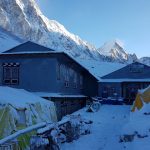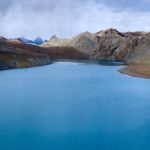Kathmandu
Kathmandu, capital of Nepal and largest city. It is the cosmopolitan heart of the Himalayan Region. It is the gateway to Nepal. It has a glorious history going back two thousand years, and a refined culture that ranks among the highest in Asia. It is also a modern financial and business hub, exotic tourist destination, and a sacred goal for pilgrims.
Kathmandu is situated in a bowl shaped valley in central Nepal. The Kingdom extends about 885 km. east to west and 193 km. in width north to south. The entire terrain is like a steep incline, descending from the icy Himalayan heights to the hot Terai flatland within a short distance.
Place to Visit In Kathmandu
Kathmandu Durbar Square
This complex of places, country yards, and temples built between the 12th and 18th used to be the seat of ancient malla kings of Kathmandu. An interesting object here is the 17th century stone inscription set into the wall of the palace with writings in 15 language.
The durbar square protected as a UNESCO world heritage site. This is the social, religious and urban focal point of city. There are also museums inside the palace building.
Some lots of world heritage places in details below:
Hanumandhoka (Durbar Square)
It is the historic seat of royalty. The durbar square, with its old temples and places, epitomizes the religious and cultural life of the people. It is here that kings of Nepal are crowned and their coronations solemnized. Interesting things to see here are; Taleju Temple built by King Mahendra Malla in 1549 A. D. Kal Bhairav, the God of destruction, Nautalle Durbar, Coronation Nasal Chok, the Gaddi Baithak, the statue of King Pratap Malla, the Big Bell, Big Drum and, the Jagannath Temple. On the right-hand corner, larger wooden latticescreen hides an enormous gilded face of Sweta Bhairav. The screen is removed only during the Indra Jatra festival.
There are also Numismatic Museum and Tribhuvan Museum inside the Hanuman Dhoka Palace building. Photography is prohibited inside the museums. Both the museums remain . closed on Tuesdays and government holidays.
The Temple of Kumari (Kumari Ghar)
The temple or the residence of Living goddess, Kumari, is situated in the vicinity of Hanuman Dhoka Palace. The building has profusely carved wooden blaconies and window screens. The Kumari- the living Goddess, acknowledges the greetings from her balcony window. Photography is prohibited.
Kasthamandap
Located near the temple of Kumari, it is said to have been built by King Laxmi Narsingha Malla in the beginning of the sixteenth century. It is said to be constructed from the wood of a single tree. The city of Kathmandu derives its name from this temple
Ashok Vinayak
The small but a very important temple of Ashok Vinayak is situated behind the Kasthamandap also known as Kathmandu Ganesh or Maru Ganesh.
Swoyambhunath Stupa: Call Monkey Temple As well
The Buddhist stupa of Swoyambhunath is situated on the top of a hill west of thecity. Swoyambhunath literally means self originated god. This 2000 years old Stupa, is one of the most sacred Buddhist religious sites in Nepal. The huge symbolic representation of Buddhahood signifies five elements through which the living being are made up of Air, Water, Fire, Earth & Either. The thirteen steps going up spirally are the steps of wisdom, crossing each spires successfully leads an individual towards the ultimate goal i.e. to attain enlightenment to liberate human kind from sufferings.
Pasupati Temple:
Not only is Pashupatinath the most important Hindu temple in Nepal. It’s one of the most important Shiva temples on the subcontinent anddraws numerous devotees from all over India each year. The temple is dedicated to lord Shiva who is the destroyer and creator of the Hindu pantheon and appears in many forms. His terrible forms are probably best known, particularly his appearance in Nepal as the cruel and destructive Bhairab, but he also has peaceful incarnations including those of Mahadev and Pashupatinath, the lord of the beasts. As the temple is located on the bank of the Bagmati River, which is considered to be the holy River, therefore Hindu people prefer to be cremated on the bank of this river – as such visiting this temple would facilitate our visitors to be acquainted with the death rituals that are being carried out.
Boudhanath :
On the eastern side of Kathmandu, just north of the Airport stands a huge Stupa of Boudhnath, the largest Stupa in Nepal and one of the biggest in the world. It is a popular religious hub of considerable population of Tibetans. Many of these Tibetans are refugees who fled their country following the unsuccessful uprising against the Chinese invaders in 1959. They have been energetic and successful enough in the intervening years, as the large houses in and around Boudhnath Testify. This is one of the few places in the world where Tibetan culture is both accessible and unhindered.
Dakshinkali Temple
Located in some what spooky location in the cleft between two hills and at the confluence of two rivers stand the temple of Dakshinkali; the temple is dedicated to Kali Shiva’s consort in her most bloodthirsty incarnation, the temple is quite famous for animal sacrifice, twice a week i.e. on Tuesday and Saturday the faithful Hindu people come here to satisfy her blood lus.
Bhudhanilkantha :
About eight kilometers north of Kathmandu, at the base of Sivapuri hill is a remarkable colossal statue of Lord Vishnu, reclining of the bed of snakes. This is one of the masterpieces of stone sculptures of Lichchhavi period. This fifth century statue is in the middle of a small pond and seems to float in water.
Patan Dusbar Squire
One of the world heritage city is Patan, official name of the municipality is Lalitpur. Patan is often considered to be the oldest and most beautiful among the three royal cities Kathmandu, Patan, Bhaktapur in the Kathmandu Valley. It is best known for its finest traditional arts and crafts and its rich cultural heritage.. View details
Our Top Offer
Why booking with us ?
- Fully Locally Owned Company
- Quality Of Service and Competitive price
- Highly Professional Staff
- Flexible and customization trip itinerary
- 100% Customer satisfaction
Need help?
Nepal: 00977-9841273869 whatsapp: 00977-984127386924 hour customer service



